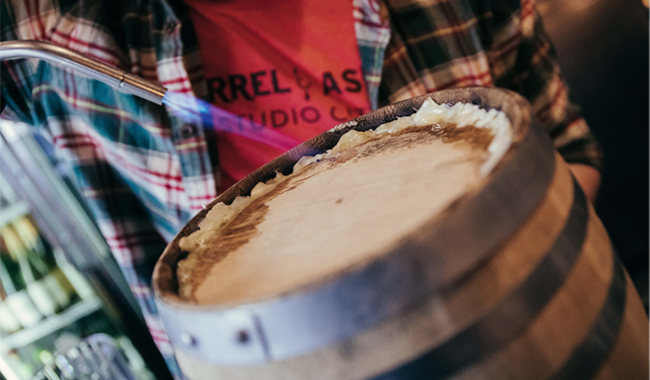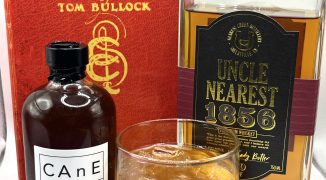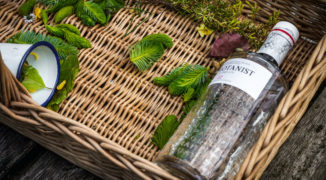Barrel and Ashes in Los Angeles may be known primarily as a barbecue place, but they have their barrel-aging program down to a science. “The first one we ever made was with moonshine, quinquina and green Chartreuse,” says Blaine Adams, Barrel and Ashes’ program director and overseer of the barrel program at the bar. “We called that the Bulletproof Monk, and we sold out of it in about two weeks, so we thought we were onto something.” Since then, the bar has acquired about 17 barrels — some currently aging drinks, some being seasoned, others waiting for cocktails. (And it’s not just cocktails they experiment with, either: “We play with finishes, so sometimes we’ll just do a port-finished rye and make Manhattans with that, and we did our own house barrel-aged bitters,” says Adams.)
Since aging isn’t as simple as mixing up a drink, pouring it into a barrel, and waiting for an indefinite amount of time, we asked Blaine to share some of the wisdom he’s learned.
Know your barrel’s lifespan
“We generally do 2-3 batches per cocktail per barrel depending on the life of barrel, and the quality of wood. Some are denser, some are lighter, some are really good, some are really bad — each barrel is kind of like its own kid, you have to learn what its strengths and weaknesses are, and act accordingly.”
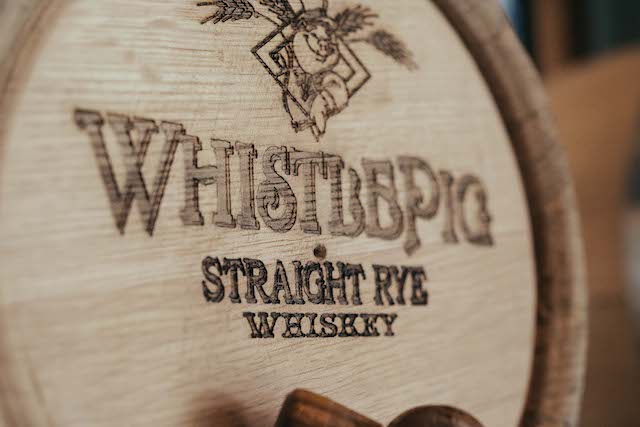 Barrel & Ashes has gotten their barrels from a number of distillers, including WhistlePig. All photos by Jim Sullivan/Medium Raw Arts.
Barrel & Ashes has gotten their barrels from a number of distillers, including WhistlePig. All photos by Jim Sullivan/Medium Raw Arts.
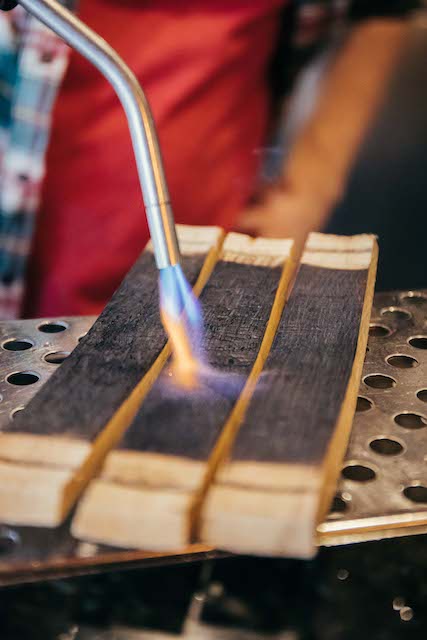 Adams uses a blowtorch to add char to the interior of a barrel.
Adams uses a blowtorch to add char to the interior of a barrel.
Get to know your wood
“Each barrel is 100% unique, but sometimes you can tell by the woodgrain: some of them are going to be a really dense wood, which you’ll get more batches out of. The denser the wood of the barrel looks, generally, you’ll have a more high-quality wood and get a better aging out of it. If it’s lower, like a more porous wood, you might get a batch or two. Five-liter batches, the little guys, are generally are good for one or two batches, maybe three, but that’s a rarity. Ten-liters, you’re looking at two to three batches, and twenty liters, three to four. You can age past that but we found that we really want the oak presence in it, and when you’re aging a cocktail versus aging spirits, generally you’re adding liqueurs, vermouths, all that jazz — a lot of sugar content. So the inside of the barrel quickly becomes seasoned because the sugars are settling in the bottom and create a thick molasses. That’s why barrel-aged cocktails tend to be a bit more mellow and sweeter, because the sugars have settled and created this heavy, thick molasses that permeates the whole thing when you pour out of the barrel.”
Keep a sharp eye out for leaks
“You have to be careful of barrel leakage. Keeping an eye on your barrels is really important. We had a barrel with a small leak, and molasses leaked out of it for a long period of time, and you lose a lot of the yield. It can add up very quickly.”
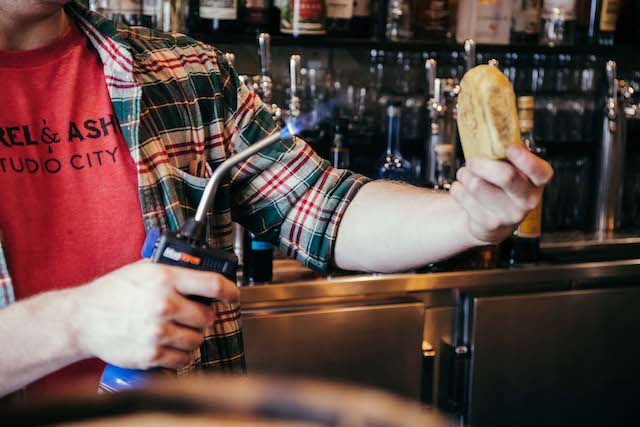 Organic beeswax can be used as a sealant to protect against barrel leaks.
Organic beeswax can be used as a sealant to protect against barrel leaks.
Seal the deal
“The best way to seal a barrel: after you get your barrel, you soak it in filtered water for a day, and look for leaks… the barrel will stain where it’s leaking. Take non-scented organic beeswax, put it in like putty, give it a quick roast, and that should block most of the holes. If the leak is really bad you might have to retire the barrel.”
Stick with high-proof
“No matter what spirit you’re using, gin, vodka, bourbon, moonshine or cognac, the best success you’ll have is you need to have something in the barrel that’s 100 proof or higher. If you put a soft spirit in the barrel, it’ll soften it to the point where a lot of people say barrel-aged cocktails are too sweet, and that’s because they’re not using a high-enough proof. Doing a barrel-aged Vesper, for example, we’re using Aviation as the base but we’re cutting in navy-strength Plymouth gin to give it a backbone. Having that high proof spirit somewhere in there, as at least a third of the cocktail, is very important. Otherwise you’ll end up with a very sweet, soft, not as enjoyable cocktail.”
Save the bitters for after the fact
“Never put bitters in a barrel with a cocktail unless you’re just barrel-aging bitters on their own. Bitters will take over anything you age and very quickly will destroy anything in the barrel. We aged a drink with cardamom bitters for a week, and by the time we were done aging, all it tasted like was cardamom and oak — none of the other flavors were there. Bitters you generally want to add after the aging.”
Oxidation might happen, but it won’t ruin your batch
“Most barrels, if sealed properly, where your spigot is inserted fully into the barrel with an airtight seal and the top bunghole is tight, in theory you’ve created an airtight environment. You’ll still have an angel’s share and all that, but for the most part, you’re not going to get a ton of oxidation as long as you fill it to the top. But when you’re using something like vermouth or Salers or Cocchi Americano, things that will oxidize and aren’t truly fortified, just be aware that oxidization will happen. Generally the oak is forgiving enough that it will round it out and soften to the point where it won’t be an issue, but there will be an oxidation.”
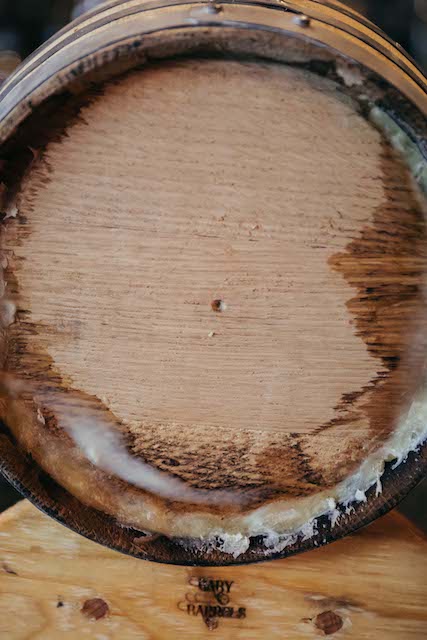
Plan and prepare for angel’s share
“Generally for costs, I usually say you’re going to lose about 10% to evaporation. It really does depend on the barrel and what you’re aging. We did barrel-aged Chartreuse for a year, but that was heavy in sugar, so it leaked a little bit with molasses. We put about twelve bottles in and got ten bottles out. The longer you age, the more you lose. When we aged the sherry amontillado for a year, we started with ten liters and ended with just under seven liters.”
They may look pretty on your backbar, but it’s best to store barrels away from light
“You want to make sure the barrels are stored in a place that doesn’t have high fluctuation in temperature, humidity and light. Getting hot and cold, or being under a heat vent, will affect what’s happening. They look good on the backbar, and they’re fun, but you definitely want to treat them like any barrel house would, if you can. What we do is, we go through maybe two or three barrels a year and when they ‘die,’ we let them dry out, take the barrel heads off, and put them on the wall so that they live on.”
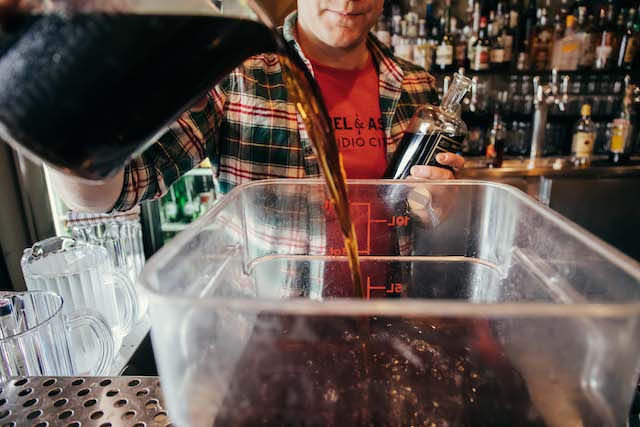 Adams batches one of the bar’s Four Roses barrel-aged cocktails.
Adams batches one of the bar’s Four Roses barrel-aged cocktails.
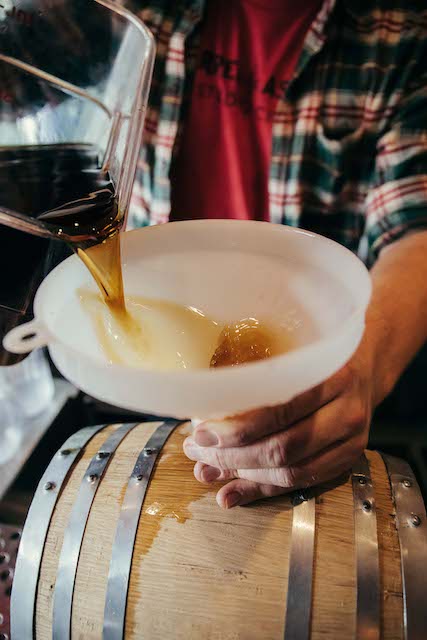 Batched contents are funneled into a barrel.
Batched contents are funneled into a barrel.
Be careful with sugar
Generally your only sweetener should be a liqueur. Honey is too thick and will sit and crystallize; maple syrup you can actually use, you just need to make sure everything else is very high proof. I wouldn’t recommend putting simple syrup in a barrel, because you run the risk of semi-fermentation. Aging the sugar, it doesn’t really do a lot. And you’d never put anything perishable in the barrel.
The starting product has to be great, too
“The barrel will take away acidity, alcohol and ethanol heat, a little of that harshness. You can’t make a bad cocktail good, but you can make a good cocktail great through barrel-aging.”
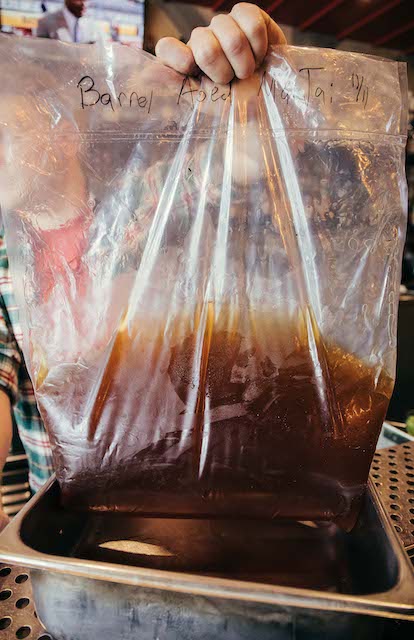 Once aging is complete, the cocktail is immediately removed from the barrel and packed into a vacuum bag.
Once aging is complete, the cocktail is immediately removed from the barrel and packed into a vacuum bag.
Set up a control cocktail for tastings
“After you fill the barrel, make sure you leave about ½ liter of unaged cocktail as a ‘control’ so you can do side by side tastes to see how much the cocktail has changed from your initial batch. Generally you want to taste as it’s aging, and you want to see where you came from. If you’re using brand-new oak, I would say taste every week to see where it’s at, because you’re rarely going to do more than 30 days on your first batch.”
Keep an eye on the time
“Every time you do a batch, you’ll have to double or triple the length of the aging process. First batch can be anywhere from 15 to maybe 35 days; once you pull that out, the barrel will already be seasoned a bit with the flavors of that cocktail, so you’re going to have to double or triple it, so it might go up to 70 or 100 days for the second batch, and the third batch might be a year. Once it’s done, we pull it out of the barrel, and put it in a vacuum sealed bag so it doesn’t oxidize. We bottle in airtight capped bottles, three or four liters’ worth, and start pouring through.”
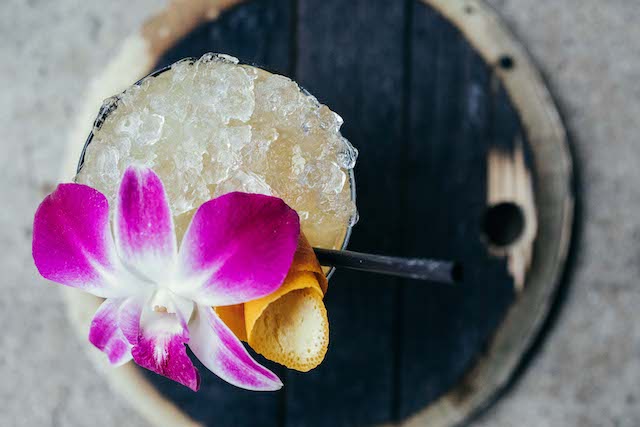 The Mai-ty Joe Rum, a five-rum blend combined with orgeat and Combier, and aged in the barrel.
The Mai-ty Joe Rum, a five-rum blend combined with orgeat and Combier, and aged in the barrel.
Don’t double-dip
“It’s like a cast iron pan — that barrel will always have those flavors in the pores of the wood. You can do another cocktail in that barrel, but it’ll still have those notes hanging out in it. We generally say, once a cocktail goes in the barrel, that’s what that barrel’s making forever — we don’t double-dip.”
Keep the barrel full, even between batches
“In between cocktail batches, make sure the barrel’s always filled with water so it doesn’t dry out. That water needs to be changed about every two to three weeks so the barrel doesn’t mold. If it does mold, you can use pH tablets or boiling water to clean it. As it’s resting, after 2 days, you can taste that water, so that if you’re doing a second batch, you’ll know what the inside of the barrel tastes like.”
Other common mistakes
“The biggest thing you see people doing that are kind of no-no’s, in my opinion, is reusing barrels over and over and over again for years with the same aging time. If you’re just putting something in there every 30 days, all you’re really doing is oxidizing a cocktail, or you’re just resting all those flavors together in a controlled environment, but you’re not barrel-aging at that point. The other one is people adding bitters or adding things that are very harsh to the barrels while they age that throws the cocktail off-balance, or they’re not adding the high proof spirit.”
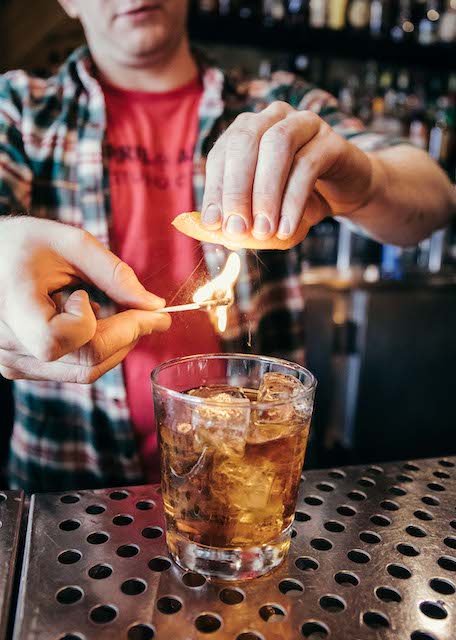 The Bullet Proof Monk, a barrel-aged bourbon, Chartreuse and China China cocktail.
The Bullet Proof Monk, a barrel-aged bourbon, Chartreuse and China China cocktail.
Ready to tackle barrel-aging? Find a little inspiration in some of Blaine’s recent recipes. See below for the specs he uses to batch out the drinks (quantities will vary based on the size of your barrel):
Mai-ty Joe Rum
- 2 oz 5 rum blend
- 1/2 oz combier
- 1/2 oz L’Orgeat Liqueur
V.I.P. (Very Important Pig)
- 1.5oz of One year house sherry finished Whistlepig rye
- 1/2oz of China-China
- 1/2oz Zucca
Bullet Proof Monk (Directors Cut)
- 2oz Belle Meade Bourbon
- 1/2 Green Chartreuse
- 1/3oz China-China
Batch quantities out to the size of your barrel. Combine ingredients and funnel into barrel. Store barrel away from light and temperature fluctuations if possible. Aging time will vary based on the age and wood of your barrel, so check every week or so. Once finished, decant and vacuum seal, or place in an air right container and refrigerate.


